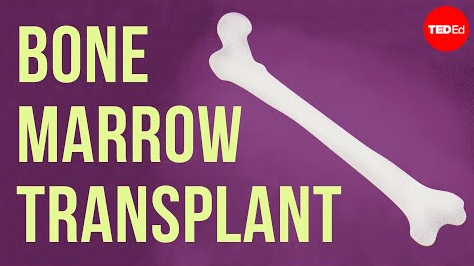At any given moment, trillions of cells are traveling through your blood vessels, sometimes circling the body in just one minute.
在任何时刻,你的血管内有几万亿细胞经过,有时候能在一分钟内在身体里循环一周。
Each of these cells has its origins deep in your bones.
这些细胞中的每一员都起源于你的骨头深处。
Bones might seem rock-solid, but they're actually quite porous inside.
骨头看上去和石块一样坚固,但它们中心其实有相当多孔。
Large and small blood vessels enter through these holes.
大小血管从这些洞里进入。
And inside most of the large bones of your skeleton is a hollow core filled with soft bone marrow.
而你骨骼中的大骨头大多数是空心的,其中填满了柔软的骨髓。
Marrow contains fat and other supportive tissue, but its most essential elements are blood stem cells. These stem cells are constantly dividing.
骨髓中含有脂肪和其它支持组织,但它最重要的成分是造血干细胞。这些干细胞一直在进行分裂。
They can differentiate into red blood cells, white blood cells, and platelets, and send about hundreds of billions of new blood cells into circulation every day.
它们可以分化成红细胞、白细胞和血小板,每天能将数千亿新生的血细胞投入人体循环。
These new cells enter the bloodstream through holes in small capillaries in the marrow.
这些新细胞通过骨髓里小毛细血管上的洞进入血液循环。
Through the capillaries, they reach larger blood vessels and exit the bone.
通过毛细血管,它们可以抵达更大的血管,离开骨头。
If there's a problem with your blood, there's a good chance it can be traced back to the bone marrow.
如果你的血液出了问题,这个问题很有可能可以追溯回骨髓。
Blood cancers often begin with genetic mutations in the stem cells.
血癌往往是由干细胞中的基因突变开始的。
The stem cells themselves are not cancerous, but these mutations can interfere with the process of differentiation and result in malignant blood cells.
干细胞本身并没有癌变,但这些突变会干扰分化的过程,产生恶性的血细胞。
So for patients with advanced blood cancers like leukemia and lymphoma,
因此,对于重症血癌,例如白血病或淋巴癌的患者来说,
the best chance for a cure is often an allogeneic bone marrow transplant, which replaces the patient's bone marrow with a donor's.
最有可能治愈的手段通常是异体骨髓移植,能将患者的骨髓替换成捐献者的骨髓。
Here's how it works. First, blood stem cells are extracted from the donor.
以下是它的原理。首先,从供者的体内采集造血干细胞。
Most commonly, blood stem cells are filtered out of the donor's bloodstream by circulating the blood through a machine that separates it into different components.
最常见的做法是,通过将血液循环通过机器将其分离成不同成分,从而将造血干细胞从供者的血液中过滤出来。
In other cases, the marrow is extracted directly from a bone in the hip, the iliac crest, with a needle.
另外的做法是,用针直接从供者髋部的骨头髂嵴中抽取骨髓。
Meanwhile, the recipient prepares for the transplant.
与此同时,受者将为移植做准备。

High doses of chemotherapy or radiation kill the patient's existing marrow, destroying both malignant cells and blood stem cells.
用高剂量的化疗或放射线照射杀死患者现存的骨髓,将癌细胞与造血干细胞同时破坏掉。
This also weakens the immune system, making it less likely to attack the transplanted cells.
这也会弱化患者的免疫系统,降低其攻击移植细胞的几率。
Then the donor cells are infused into the patient's body through a central line.
接下来,供者的细胞将通过静脉注射输注给患者。
They initially circulate in the recipient's peripheral bloodstream,
这些细胞先在受者的外周血液中循环,
but molecules on the stem cells, called chemokines, act as homing devices and quickly traffic them back to the marrow.
不过干细胞上被称为“趋化因子”的分子起到归巢作用,引导这些干细胞快速迁移回骨髓中。
Over the course of a few weeks, they begin to multiply and start producing new, healthy blood cells.
在几个星期的时间里,它们的数量开始增长,并开始制造新的健康血细胞。
Just a small population of blood stem cells can regenerate a whole body's worth of healthy marrow.
只需要少许造血干细胞,就能再生整个身体所需的健康的骨髓。
A bone marrow transplant can also lead to something called graft-versus-tumor activity,
一次骨髓移植也可以产生所谓的“移植物抗肿瘤”效应,
when new immune cells generated by the donated marrow can wipe out cancer cells the recipient's original immune system couldn't.
即移植骨髓产生的新免疫细胞能够抹杀受者原来的免疫系统无法杀灭的癌细胞。
This phenomenon can help eradicate stubborn blood cancers.
这个现象能帮助患者清除顽固的血癌细胞。
But bone marrow transplants also come with risks, including graft-versus-host disease.
但是骨髓移植也伴随风险,包括移植物抗宿主病。
It happens when the immune system generated by the donor cells attacks the patient's organs.
这种病症会让由供体细胞生成的免疫系统攻击患者的器官。
This life-threatening condition occurs in about 30–50% of patients who receive donor cells from anyone other than an identical twin,
这种危机生命的病症会发生在约30%-50%那些没有从同卵双胞胎获得供体细胞的患者身上,
particularly when the stem cells are collected from the blood as opposed to the bone marrow.
尤其是在干细胞是从血液中而不是从骨髓中采集的情况下。
Patients may take immunosuppressant medications or certain immune cells may be removed from the donated sample in order to reduce the risk of graft-versus-host disease.
通过让患者服用免疫抑制药,或者将特定免疫细胞从捐献的样本中移除,可以降低移植物抗宿主病的风险。
But even if a patient avoids graft-versus-host disease, their immune system may reject the donor cells.
然而即使患者躲过了移植物抗宿主病,他们的免疫系统还是有可能排斥供体细胞。
So it's crucial to find the best match possible in the first place.
因此,在第一步找到尽可能匹配的捐献者至关重要。
Key regions of the genetic code determine how the immune system identifies foreign cells.
遗传基因中有关键区域决定免疫系统如何识别外来细胞。
If these regions are similar in the donor and the recipient, the recipient's immune system is more likely to accept the donor cells.
如果供者和受者的这些区域比较相似,受者的免疫系统就更有可能接受供者的细胞。
Because these genes are inherited, the best matches are often siblings.
因为这些基因是遗传的,最好的配型一般是兄弟姐妹。
But many patients who need a bone marrow transplant don't have a matched family member.
但是很多需要骨髓移植的患者并没有匹配的家庭成员。
Those patients turn to donor registries of volunteers willing to offer their bone marrow.
这些患者转而求助于愿意捐献骨髓的志愿者资料库。
All it takes to be on the registry is a cheek swab to test for a genetic match.
想成为骨髓捐献者,只需用棉签刮口腔进行基因配型。
And in many cases, the donation itself isn't much more complicated than giving blood.
大多数情况下,骨髓捐献本身并不比献血麻烦多少。
It's a way to save someone's life with a resource that's completely renewable.
这种办法可以通过完全可再生的资源拯救某个人的生命。













